![]()
This article is part of a larger series on Hiring.
Get Your Free Hiring Ebook
Send to me![]()
A good applicant tracking spreadsheet can help organize your hiring process, allowing you to track applications, multiple interviews, and even test results. Using a candidate tracking spreadsheet is best if you:
We’ve created two free Excel templates (also downloadable in Google Sheets), a job-specific recruitment template for individual hiring teams and a master tracking sheet of all applicants across all roles for HR or the hiring manager.
FILE TO DOWNLOAD OR INTEGRATE
Download as Excel Download as Google Sheets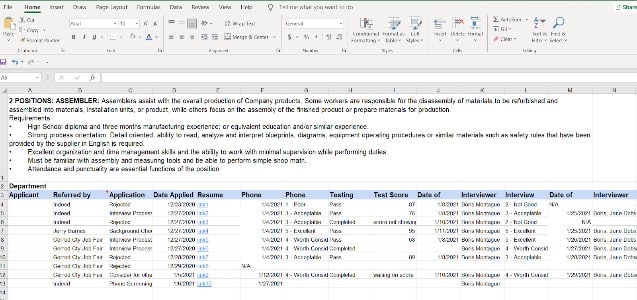
💡 Quick Tip: If you’ve outgrown a spreadsheet, consider our recommended applicant tracking software, Freshteam. It’s free for up to 50 users and allows for 3 published job postings before needing to upgrade. Its free plan also comes with Interview scorecards, Canned responses, and the ability to schedule automated follow up emails.
Select Download Type FILE TO DOWNLOAD OR INTEGRATE HR Applicant Master Tracker Download as Excel Download as Google Sheets![]()
💡 Quick Tip: If you’ve outgrown a spreadsheet, consider our recommended applicant tracking software, Freshteam. It’s free for up to 50 users and allows for 3 published job postings before needing to upgrade. Its free plan also comes with Interview scorecards, Canned responses, and the ability to schedule automated follow up emails.
Select Download TypeOur templates can be downloaded for free, using either Excel or Google Sheets, and customized for your specific needs. They are easy to use and help optimize the hiring process. For a walkthrough of each spreadsheet, watch our instructional video below.
Expand the sections below for written template instructions: Recruitment TemplateWe created a recruitment template for tracking job applicants, which you can share with your hiring team so everyone is working with the same data. Using a tracking template keeps applicant information at your fingertips and makes it easy to check on status, feedback, red flags, and other information important to the hiring process.
FILE TO DOWNLOAD OR INTEGRATE Free Excel Recruitment Template Download as Excel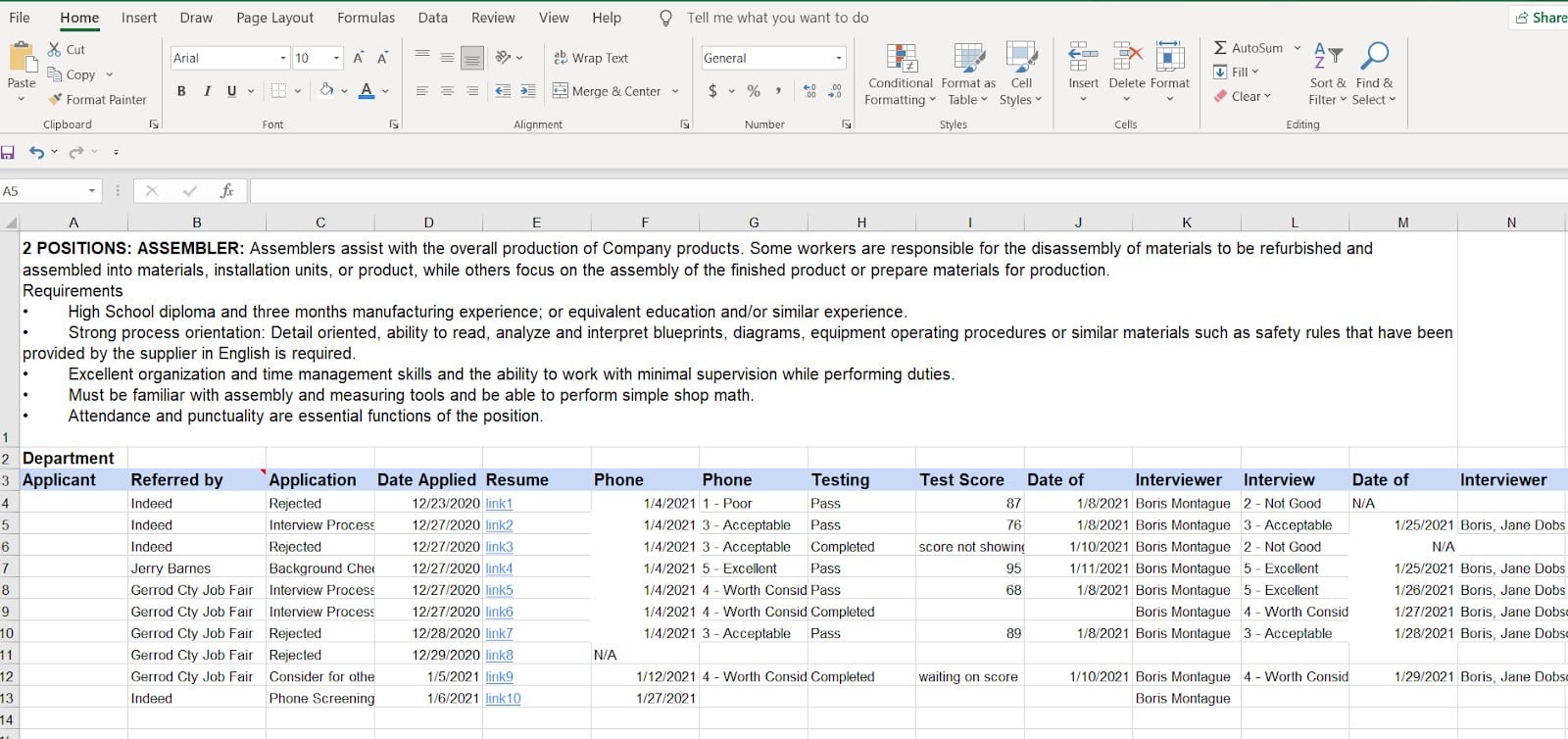
💡 Quick Tip: If you’ve outgrown a spreadsheet, consider our recommended applicant tracking software, Freshteam. It’s free for up to 50 users and allows for 3 published job postings before needing to upgrade. Its free plan also comes with Interview scorecards, Canned responses, and the ability to schedule automated follow up emails.
Select Download TypeLet’s look at each element and how to best use the template. 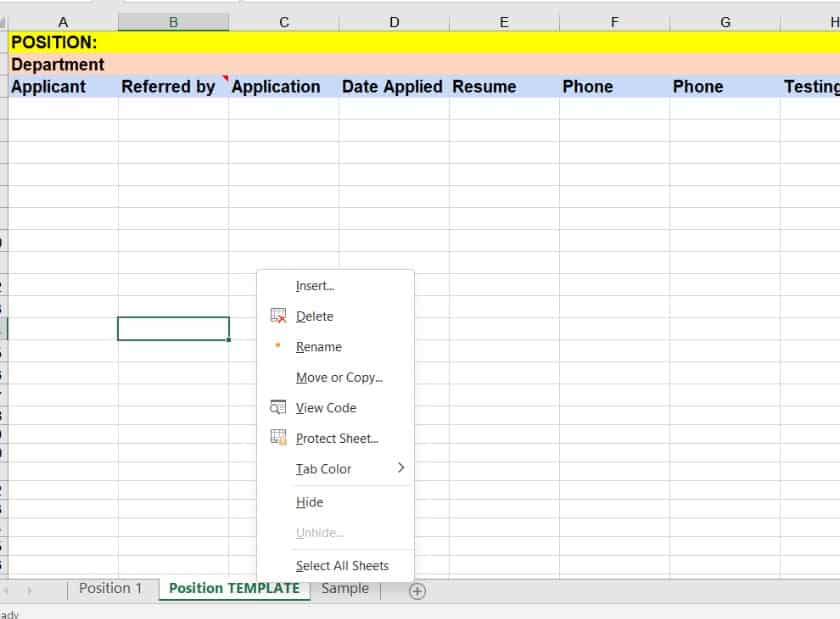 Position: This spreadsheet was created to be job-specific. At the bottom of the file, you will see tabs marked Position 1, Position TEMPLATE, and Sample. Position 1 is ready for you to fill in with your first job. Save Position TEMPLATE for future jobs. You can modify the cells to fit your applicant procedures. When starting a new hiring process, right-click on the Position TEMPLATE tab and select Move or Copy. Select the sheet you wish to place the copy and check the box next to Create a Copy. This will create another tab that you can rename. The Sample tab shows you how you might use the template.
Position: This spreadsheet was created to be job-specific. At the bottom of the file, you will see tabs marked Position 1, Position TEMPLATE, and Sample. Position 1 is ready for you to fill in with your first job. Save Position TEMPLATE for future jobs. You can modify the cells to fit your applicant procedures. When starting a new hiring process, right-click on the Position TEMPLATE tab and select Move or Copy. Select the sheet you wish to place the copy and check the box next to Create a Copy. This will create another tab that you can rename. The Sample tab shows you how you might use the template. 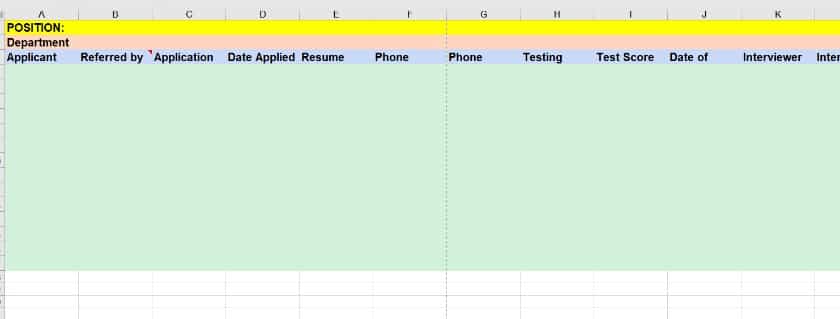 Row 1 (Yellow): Put the job title and description at the top of the page. This is for the edification of your hiring team only. You can copy and paste this from the official job posting or put a summary of what interviewers should be considering. Row 2 (Peach): Put the department you are hiring for or the responsible hiring party, whatever information is most important for the team to keep in mind. Row 3 (Blue): This row is the header row (auto-filled) that lists the description for each column. You can modify this row to fit your needs. Row 4–104 (Green): The current template is set up for 100 candidates. If you need more, highlight and copy an entire row, then paste it. That will let you keep the drop-down menu choices.
Row 1 (Yellow): Put the job title and description at the top of the page. This is for the edification of your hiring team only. You can copy and paste this from the official job posting or put a summary of what interviewers should be considering. Row 2 (Peach): Put the department you are hiring for or the responsible hiring party, whatever information is most important for the team to keep in mind. Row 3 (Blue): This row is the header row (auto-filled) that lists the description for each column. You can modify this row to fit your needs. Row 4–104 (Green): The current template is set up for 100 candidates. If you need more, highlight and copy an entire row, then paste it. That will let you keep the drop-down menu choices. 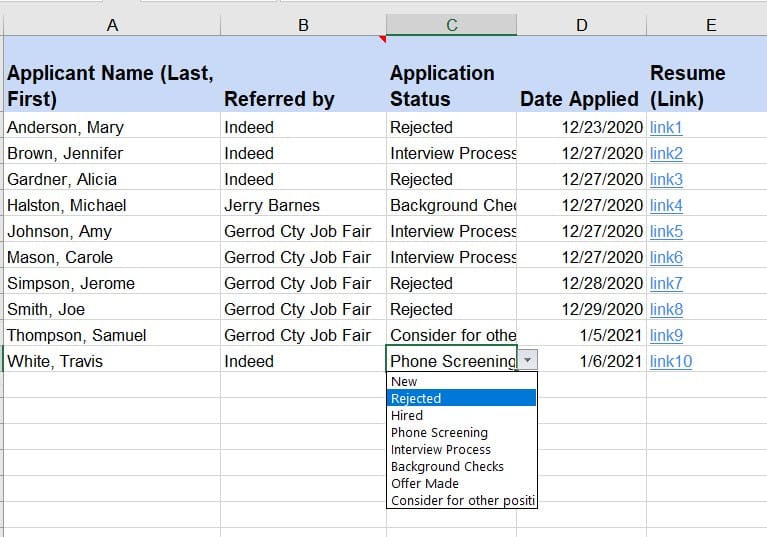 Column A: Put the applicant’s last name first so that it’s easy to sort alphabetically. Column B: Knowing the reference can help give insight into the candidate. For example, if an employee refers another person for a position, you can ask them about the candidate. You can modify this column by making a menu of choices, but we chose to leave it fillable so you can get more precise (like referral names). Column C: The application status lets you know where a particular candidate is in the process. You can also use color-coding to make it easier to spot active vs rejected candidates. If you like a candidate but not for that job, the “Consider for another job” option is useful. This column has a pre-filled drop-down menu (as shown above). Column D: Place the date the applicant applied in Column D. Column E: Resumes can be referred to with links or notes as to where they are stored, such as a Google Doc or a job board, like ZipRecruiter.
Column A: Put the applicant’s last name first so that it’s easy to sort alphabetically. Column B: Knowing the reference can help give insight into the candidate. For example, if an employee refers another person for a position, you can ask them about the candidate. You can modify this column by making a menu of choices, but we chose to leave it fillable so you can get more precise (like referral names). Column C: The application status lets you know where a particular candidate is in the process. You can also use color-coding to make it easier to spot active vs rejected candidates. If you like a candidate but not for that job, the “Consider for another job” option is useful. This column has a pre-filled drop-down menu (as shown above). Column D: Place the date the applicant applied in Column D. Column E: Resumes can be referred to with links or notes as to where they are stored, such as a Google Doc or a job board, like ZipRecruiter. 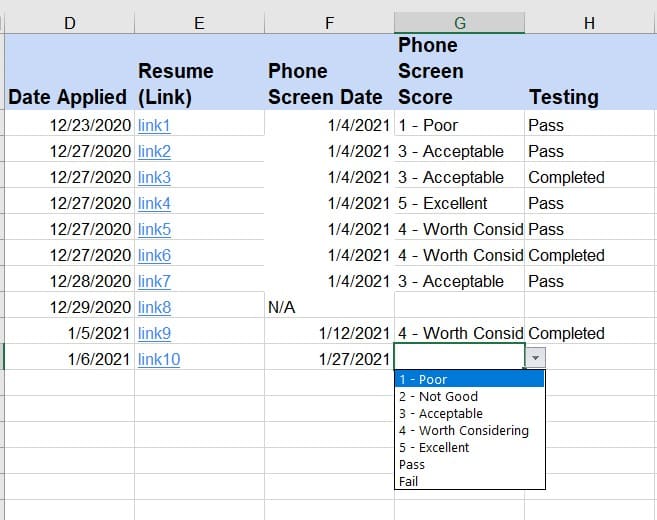 Column F: If your company has a policy of phone screenings (quick interviews to weed out unqualified candidates), then record that date in this column. Column G: This column offers drop-down menu choices for scoring. It offers a pass/fail option and a scale of 1–5. The menus are easy to change if you prefer something more specific, such as PASS/FAIL, UNQUALIFIED/FAIL, UNINTERESTED/FAIL, POOR COMMUNICATION, etc.
Column F: If your company has a policy of phone screenings (quick interviews to weed out unqualified candidates), then record that date in this column. Column G: This column offers drop-down menu choices for scoring. It offers a pass/fail option and a scale of 1–5. The menus are easy to change if you prefer something more specific, such as PASS/FAIL, UNQUALIFIED/FAIL, UNINTERESTED/FAIL, POOR COMMUNICATION, etc. 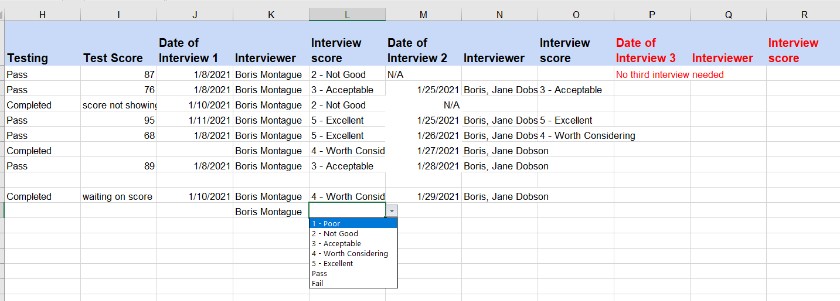 Column H: Some companies ask potential candidates to take online or in-person tests, such as for analytical skills, word processing, or trade skills. Here, you can track if the candidate is scheduled or has taken the test, and whether they have passed or failed using the drop-down. Column I: This column is used for testing scores. We left the score as fillable to accommodate the many ways that one can be graded. Columns J–R: Use these columns to record the date, interviewer, and score of each interview conducted. We allowed for three interviews, but of course, you can either delete some columns or leave them blank. The drop-down for the Interview Score uses the same pass/fail or 1–5 criteria as the Phone Screen Score.
Column H: Some companies ask potential candidates to take online or in-person tests, such as for analytical skills, word processing, or trade skills. Here, you can track if the candidate is scheduled or has taken the test, and whether they have passed or failed using the drop-down. Column I: This column is used for testing scores. We left the score as fillable to accommodate the many ways that one can be graded. Columns J–R: Use these columns to record the date, interviewer, and score of each interview conducted. We allowed for three interviews, but of course, you can either delete some columns or leave them blank. The drop-down for the Interview Score uses the same pass/fail or 1–5 criteria as the Phone Screen Score. 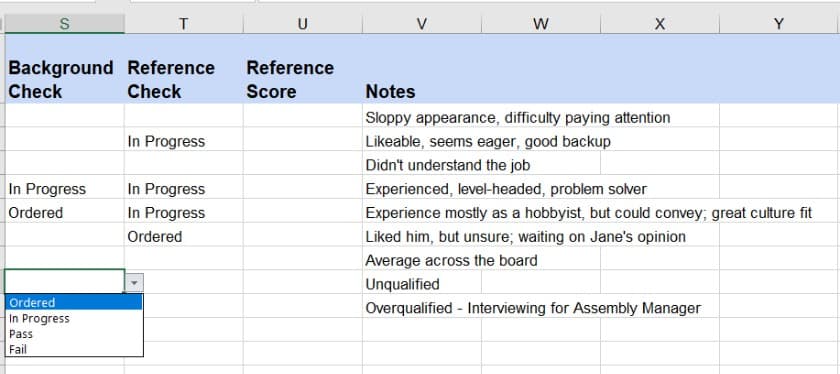 Column S: At any point in the process, you may want to conduct a background or reference check to verify qualifications. (Drug testing is in the HR Applicant Tracker.) The background check menu offers a simple pass/fail in addition to ordered and in progress. Columns T–U: These columns are to notate reference checks. Column T has a drop-down that shows if the reference check is ordered, in progress, or complete. Column U offers a place for a score. The drop-down score shows pass/fail or a score of 1-5. Column V: This column is used to make any notes regarding the candidate.
Column S: At any point in the process, you may want to conduct a background or reference check to verify qualifications. (Drug testing is in the HR Applicant Tracker.) The background check menu offers a simple pass/fail in addition to ordered and in progress. Columns T–U: These columns are to notate reference checks. Column T has a drop-down that shows if the reference check is ordered, in progress, or complete. Column U offers a place for a score. The drop-down score shows pass/fail or a score of 1-5. Column V: This column is used to make any notes regarding the candidate.
You can make comments in any of the cells—for example, if you want to make a note that an interview had to be rescheduled or add some kind of explanation about a test score. Simply click in the cell you wish to make a comment on and select Insert > Comment.
HR Applicant Tracker SpreadsheetWe also created an HR Applicant Master Tracker, which includes needed but sensitive information, where you can track all candidates for all positions. This template is similar to the recruitment template but has a bird’s-eye view. You can list all jobs and applicants; however, rather than all the details of interview ratings, this holds the contact and demographic information, the overall progress (such as the latest interview date), and the hiring results. We set this up for 100 candidates. If you need more, highlight and copy an entire row, then paste it. That will let you keep the menu choices.